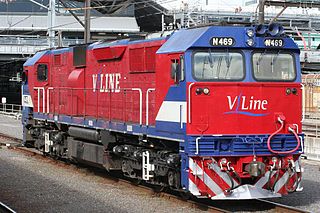
The Hitachi was an electric multiple unit train that operated on the Melbourne suburban railway network between 1972 and 2014. Electrical equipment was supplied by Commonwealth Engineering, to designs by Hitachi of Japan, leading to their official name today, although no Hitachi-supplied components were used in their construction. They were the last suburban trains in Melbourne without air conditioning. A total of 355 carriages were built between 1972 and 1981, including a replacement carriage for one written off while the fleet was still being delivered.

A Zed & Two Noughts is a 1985 film written and directed by Peter Greenaway. This film was Greenaway's first collaboration with cinematographer Sacha Vierny, who went on to shoot virtually all of Greenaway's work in the 1980s and 1990s, until Vierny's death. Greenaway referred to Vierny as his "most important collaborator". The film deals with twin zoologists who, after losing both their wives in a car accident, develop an obsession with animal decomposition.

The Strongest Man in the World is a 1975 American science fiction comedy film directed by Vincent McEveety, produced by Walt Disney Productions, and starring Kurt Russell, Joe Flynn and Eve Arden. It was the third and final film in Dexter Riley series.

Martin & King was a manufacturing company based in Clayton, Victoria, Australia. The company originally specialised in making motor vehicle bodies and railway locomotives and rolling stock.

The DRC was a class of railmotor operated by the Victorian Railways on its country rail network in Victoria, Australia. The cars were built by Tulloch Limited in New South Wales, and featured aluminium and steel construction, air-conditioning, and twin diesel engines with hydraulic transmissions.

The S type carriages are a corridor-type passenger carriage used on the railways of Victoria, Australia. The first carriages were constructed by the Victorian Railways in 1937 for use on the Spirit of Progress, with additional carriages built for other trains until the mid-1950s.

The Z type carriages are an air conditioned steel passenger carriage used on the railways of Victoria, Australia. The carriages were constructed by the Victorian Railways from 1957 for use on interstate services.

The W type carriages were wooden passenger carriages used on the railways of Victoria, Australia. There were two variants, short- and long-body vehicles, and this article deals with the former. Details on the latter can be found here.
The MT type carriages were railmotor trailers, used on the Victorian Railways (VR) in Australia.
The Victorian Railways (VR) of Australia and successors have utilised a number of different types of railway carriages and wagons for the supply of head end power to passenger trains on the Victorian railway network.
The Victorian Railways and successors used a variety of railway wagons for the transport motor cars.
The Victorian Railways used a variety of railway wagons for the transport of livestock.
This article contains information on Victorian Railways rolling stock that do not fit into other categories. These were for the most part "one-offs"; many were not classified.
As the Victorian Railways' fleet of Z vans began to age, the railways decided to invest in bogie designs for vans. Some van designs were included in a class of new passenger vehicles. Many other vans, for both freight and passenger work, were built separately from any other rolling stock developments, and these are the ones that feature here in detail.

Stolen is a 2012 American action thriller film directed by Simon West and starring Nicolas Cage, Danny Huston, Malin Åkerman, M. C. Gainey, Sami Gayle, Mark Valley and Josh Lucas. The film follows a former thief who has 12 hours to find $10 million and save his daughter from his former partner. It was released in the United States on September 14, 2012.
The first passenger carriages of the Victorian Railways (VR) were fixed-wheel, with a mixture of first- and second-class bodies on either four- or six-wheeled underframes. They were built to the British side-loading, swing-door, cross bench compartment (non-corridor) style; later a saloon style was used to a limited extent, featuring fewer doors per side and perimeter seating - which increased total capacity by allowing more standing passengers.
The Victorian Railways used a variety of boxcars or covered goods wagons for the transport of all manner of goods. This page covers the history and development of the various classes, and how they changed through their lives.
The Victorian Railways used a variety of air-cooled and iced wagons or refrigerated vans for the transport of all manner of goods. This page covers the history and development of the various classes, and how they changed through their lives.

The W type carriages were wooden passenger carriages used on the railways of Victoria, Australia.

Titane is a 2021 body horror psychological drama film written and directed by Julia Ducournau. The French-Belgian co-production stars Agathe Rousselle in her feature film debut as Alexia, a woman who, after being injured in a car crash as a child, has a titanium plate fitted into her head. In adulthood, Alexia becomes a murderous car model with an erotic fascination with automobiles, leading to a bizarre sexual encounter that sets off an increasingly outlandish series of events. Vincent Lindon, Garance Marillier and Laïs Salameh also star.











